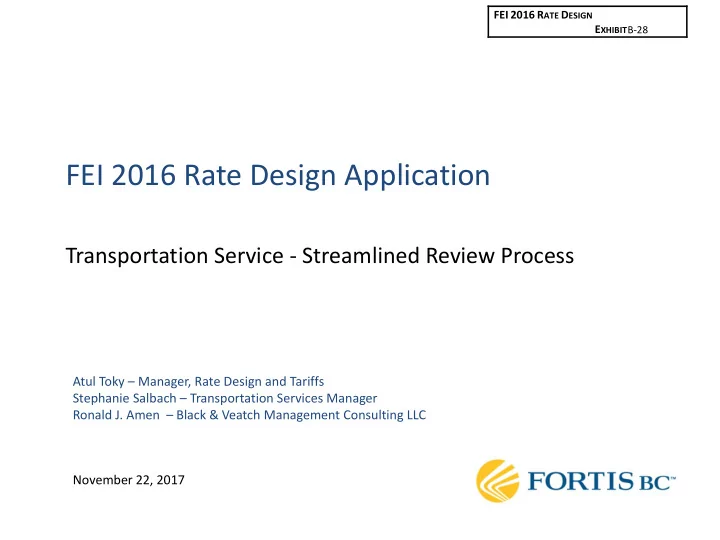

FEI 2016 R ATE D ESIGN E XHIBIT B-28 FEI 2016 Rate Design Application Transportation Service - Streamlined Review Process Atul Toky – Manager, Rate Design and Tariffs Stephanie Salbach – Transportation Services Manager Ronald J. Amen – Black & Veatch Management Consulting LLC November 22, 2017
Transportation Service Review – SRP Information Session & Stakeholder Workshop – 2016 • Inform and Review Transportation Service • Discussion Guide for Workshop • Key Issues/Topics for Discussion Application – Exhibit B-1, Section 10 Post Application Workshops – early 2017 Reviewed by External Consultants • Black & Veatch • Elenchus Two Rounds of Information Requests - 2 -
Black & Veatch – The Need for Balancing Balancing refers to the daily matching of deliveries of natural gas supplies to FEI’s distribution system from various upstream sources with the aggregate daily demands of its customers • Performance of this daily balancing function ensures reliable gas supplies are available for both FEI’s sales and transportation customers • FEI must balance its system daily in conformance with the requirements of upstream long-haul transportation pipelines • FEI’s transportation customers deliver and receive differing amounts of natural gas on a day-to-day basis, contributing to system imbalances • FEI uses the midstream assets that serve sales customer demands (e.g., leased storage injections or withdrawals) to balance the system • Two types of balancing charges are common in the utility industry ⁻ Balancing Service Charges levied on all volumes transported ⁻ Tiered balancing tolerance levels with associated charges - 3 -
Black & Veatch Analysis: Replacement Cost • Initially developed a replacement cost methodology to place a value on FEI’s balancing services • Based on assumption that if balancing services were not offered by FEI, shipper agents would procure their own firm resources to meet their balancing needs 75% of the time – Trade off between risk of incurring imbalance charges and over- contracting for firm resources - 4 -
Black & Veatch Analysis: Tolerance Level • Based on feedback from the August 12, 2016 workshop, FEI and Black & Veatch began to focus on where to set the balancing tolerance level rather than determining an optimal charge for balancing services • Compared FEI’s daily balancing tolerance level to its industry peers, since daily balancing predominates across North America • Assessed the capabilities of FEI’s shipper agents to balance to 10% and 20% daily threshold levels using historical data (see “Balancing Tolerance” section) - 5 -
Black & Veatch Analysis: Tolerance Level See notes to Figure 1 in Black & Veatch’s Transportation Service Model Review report • FEI’s current balancing tolerance level of 20% is high by industry standards • A common tolerance level is 5%, which is viewed as an industry standard, with 10% being another less common threshold on the high-end • Utilities with no specified daily tolerances provide daily balancing services for fee (e.g., PSE) or balance on their affiliated upstream pipelines - 6 -
FEI’s Transportation Service Proposals As presented in the Application 1 • Eliminate monthly balancing • Amend balancing tolerance from 2 20% to 10% • Implement tiered balancing 3 charges - 7 -
What is balancing and trending to zero? - 8 -
FEI Daily Load Balancing Function Overview - 9 -
#1 Daily and Monthly Balancing - 10 -
History of Balancing Provisions Daily and monthly balancing provisions exist RS 22 daily balanced RS 23, 25, 26 and 27 balance monthly Rules and charges - 11 -
Different Balancing Practices - 12 -
Daily and Monthly Combined Days of Supply Held on Behalf of all Shipper Agents on FEI’s System Ref: Ex. B-1, Figure 10-6 - 13 -
Balancing Options Status Quo 1 Modified Monthly 2 Daily Balancing 3 - 14 -
Reasons for Daily Balancing Daily balancing is industry practice • FEI is held to daily balancing Tools now exist • Marketers balancing daily today Fairness • All held to unified set of rules - 15 -
Reasons for Daily Balancing Reduce arbitrage • At expense of sales customers Improved system efficiency • Less reliance on Midstream resources Stakeholder feedback - 16 -
#2 Balancing Tolerance - 17 -
Daily Balancing Surcharge Calculation - 18 -
Total Transportation Daily Imbalances Ref. Ex. B-2, pg. 39 - 19 -
Balancing Tolerance Options Status quo 1 Balancing fee 2 Tighten the tolerance to 10% 3 - 20 -
Industry Review – Black & Veatch - 21 -
Managing to 10% today Ex. B-11, CEC IR 1.54.1 - 22 -
#3 Balancing Charges - 23 -
Balancing Tolerance Charges Ref. Ex. B-1, Table 10-10 - 24 -
Tiered Approach - Impact/Rationale • Price signal • More efficient use of FEI’s midstream resources • Credit to midstream portfolio - 25 -
Balancing Tolerance Charges Ref: Ex. B-1, Table 10-9 - 26 -
Transportation Proposal Summary 1. Eliminate monthly balancing 2. Amend balancing tolerance from 20% to 10% 3. Implement tiered balancing charges - 27 -
For further information, Find FortisBC at: please contact: Fortisbc.com Gas.Regulatory.Affairs@fortisbc.com www.fortisbc.com/ratedesign 604-576-7000 - 28 -
Recommend
More recommend